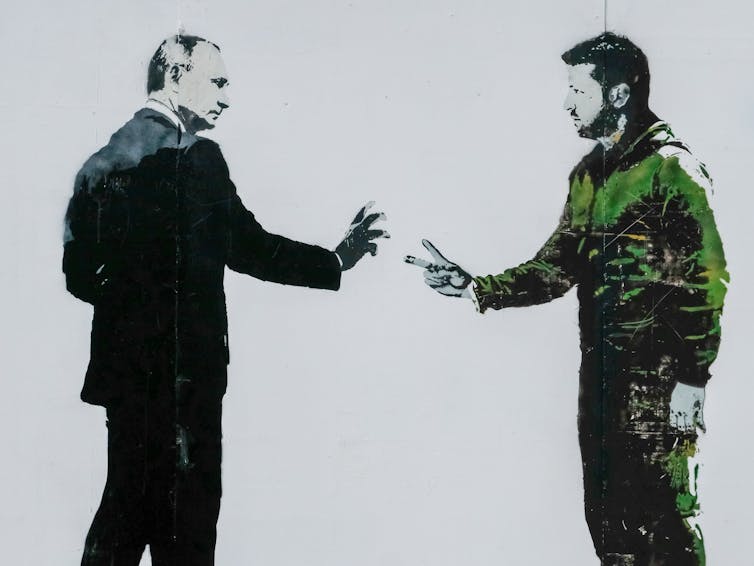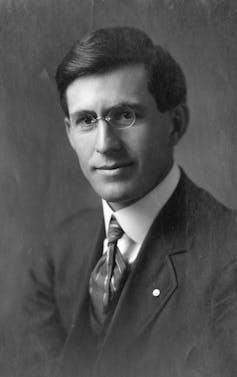The Ukraine conflict is a war of narratives – and Putin’s is crumbling

People understand the world – that is, where we came from, how we got here and where we are likely to go – through the stories we tell about ourselves and others. Indeed, the political and social environments in which we are embedded are rooted in these stories, these narratives.
And so it is with the current conflict in Ukraine. As the months of fighting have progressed, so too have the narratives that underpin the actions of the two sides. It is as if both Russia and Ukraine are attempting to write the history – the whys and hows of the conflict – in real time.
As a historian, I know narratives have problems. First, although they may be true and relate to facts and actual occurrences, narratives that take hold can also be completely fabricated. Second, once a narrative is put out there, the implication is that whatever story you tell is just as valid as the one your opponent tells. Often, it is not.
Take the case of Russia and its disastrous war in Ukraine. Russian politicians and their media claim Russia is fighting Nazis in Ukraine who usurped power in a 2014 coup d’état and pushed the country toward an alliance with the West, posing a direct threat to Russia itself.
In this narrative, Russian boys are dying to protect their Ukrainian brethren, Russians and Russian-speaking Ukrainians from fascism – just as their ancestors did during the Second World War.
For Ukrainians and most people in the West, this Kremlin-inspired narrative is patently false. Their counternarrative is that Ukrainians decided in the “revolution of dignity” in 2014 that they wanted to free themselves from Vladimir Putin’s suffocating pressure to give up their aspirations to join the West, fortify their democracy and be a fully sovereign, independent state. Inspired by that narrative – and the unprovoked invasion of their country by their powerful neighbor – Ukrainians have courageously and effectively resisted the Russian assault, and even triumphed significantly on the battlefield.
Perceived existential threats
The truth is, Ukraine was never a serious, immediate threat to Russia. But for Putin and his supporters, anxious about their loss of geopolitical clout vis-à-vis the United States and NATO, Ukraine’s gravitation toward the West portended a vulnerable future.
This narrative pushed Putin into what he sees as a preventive war. It is premised on anxieties about future dangers, yet clothed not in cold realist terms but rather in the hyperemotional narrative of the supposedly harmonious brotherhood of Russians, Ukrainians and Belarusians.
Ukrainians do not have to manufacture grand narratives that fly in the face of facts. Yet exaggerations in wartime are almost inevitable. The government in Kyiv, as well as Western leaders, claims that the war has become a struggle for the very existence of the Ukrainian nation, that Putin is determined to eliminate Ukrainians as Ukrainians.
If that narrative is true – which I believe it is not – then there can be no compromise with Russia.
Putin’s narrative is similarly existential. It is framed as a struggle against the “neo-colonialism” of the West, which he believes seeks to dismember Russia. In Putin’s narrative, the war with Ukraine challenges America’s claim to a global hegemony that reduces Russia to a humiliated regional power.
Broadening the threat
In his speech on Sept. 30, 2022, annexing Ukraine’s Donetsk, Luhansk, Kherson and Zaporizhzhia to Russia, Putin used history to justify his imperial grab. The lands he referred to as “New Russia,” or “Novrossiya,” were sanctified, he said, by victories of Russian heroes from the 18th century; this was a land where Catherine the Great founded cities.
He then pivoted to the painful year 1991, when three representatives of the Communist party elite terminated the Soviet Union “without asking ordinary citizens what they wanted, and people suddenly found themselves cut off from their homeland.” Putin compared this illegitimate act with what Lenin and the Bolsheviks had done in creating Soviet republics on the basis of their nationality. In Putin’s narrative, the invasion of Ukraine is part of a process to rectify what he now sees as criminal acts at the dawn and twilight of the Soviet empire. He explicitly rejected the notion of restoring the USSR – “Russia no longer needs it today; this is not our ambition” – but believes he should aid those torn from their historic homeland.
In Putin’s narrative, Ukraine needs saving from the clutches of the West and Western culture and must return to the Russkii mir – the Russian world – and its unique culture.
In his speech, Putin declared that in Russia there will not be “parent number one, parent number two and parent number three” instead of a “mother and father.” He continued: “Do we want our schools to impose on our children … perversions that lead to degradation and extinction? Do we want to drum into their heads the ideas that certain other genders exist along with women and men and to offer them gender reassignment surgery? … This is all unacceptable to us. We have a different future of our own.”
This move to include a perceived attack on Russian values as part of Putin’s defense of his actions in Ukraine – broadening the imagined threat from the West to include culture as well as Russia’s survival and status as a great power – comes amid suggestions that Moscow’s existing narratives are failing.
Domestic resistance to the war has erupted sporadically in large Russian cities, in non-Russian regions like Dagestan and even in Russian-occupied Crimea. Young men are fleeing to Finland, Georgia, Armenia and Central Asia to avoid the call-up issued by the military. Few want to fight and die for a war that makes no sense.
Backed into a corner
Historians look back into the past to find out how we arrived where we are in the present. Investigating that past can help us understand why the war in Ukraine occurred and may in fact help us find a way out of the conflict. But neither illuminating the causes of the war nor the possible outcomes necessarily leads this conflict to a common narrative to which both sides can subscribe.
And narratives, once expressed, can take on a life of their own. The Soviet vision of a bright future that Putin grew up with lies shattered in a now distant past. He has attempted to replace it with an alternative heroic narrative, fearing where history is taking him and his countrymen otherwise. But that too, looks to be a narrative in danger of crumbling in the face of reality.
Ronald Suny, Professor of History and Political Science, University of Michigan
This article is republished from The Conversation under a Creative Commons license. Read the original article.








 Praise effort: It’s easy to fall into the habit of praising successes. However, praising effort encourages children to try new things without the fear of failing. It also teaches children personal growth and achievement are possible, even if their overall effort wasn’t a success.
Praise effort: It’s easy to fall into the habit of praising successes. However, praising effort encourages children to try new things without the fear of failing. It also teaches children personal growth and achievement are possible, even if their overall effort wasn’t a success.






